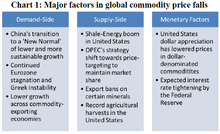Commodity price shocks
Commodity price shocks are times when the prices for commodities have drastically increased or decreased over a short span of time.[1]
Post-Napoleonic Irish grain price and cropland rent shocks (1815–1816)
During the international Post-Napoleonic depression (1815–1821) following the conclusion of the Coalition Wars (1792–1815), wheat and other grain prices fell by half in Ireland, and alongside continued population growth, landlords converted cropland into rangeland by securing the passage of tenant farmer eviction legislation in 1816, which led, because of the Irish workforce's historic concentration in agriculture, to a greater subdivision of remaining land plots under tillage and increasingly less efficient and less profitable subsistence farms.[2][3]
1971–1973
At the time of the 1973 oil crisis, the price of corn and wheat went up by a factor of three.
2000s decade
During the 2000s, the price of Brent Crude rose above $30 a barrel in 2003 before peaking at $147.30 in July 2008. With the onset of the Great Recession, reduced demand for oil caused the price to fall to $39 per barrel in December 2008.[4]
The 2007–08 world food price crisis saw corn, wheat, and rice go up by a factor of three when measured in US dollars.
Second half of 2014

Global commodity prices fell 38% between June 2014 and February 2015. Demand and supply conditions led to lower price expectations for all nine of the World Bank's commodity price indices - an extremely rare occurrence. The commodity price shock in the second half of 2014 cannot be attributed to any single factor or defining event.[6] It was caused by a host of industry-specific, macroeconomic and financial factors which came together to cause the simultaneous large drops across many different commodity classes. Amongst these, the transition of China's economy to more sustainable levels of growth and the shale-energy boom in the United States were the dominant demand-side and supply-side factors governing the downturn in global commodity prices.[7]
2020
On April 20, 2020, WTI's May contract closed at -$37.63/barrel while the June contract closed at positive $20.43/barrel. The main cause is due to the ongoing COVID-19 pandemic which has reduced demand along with storage issues and the expiration of the May contract the following day.[8]
See also
External links
References
- https://scholar.google.com/scholar?hl=en&q=commodity%20price%20shocks&um=1&ie=UTF-8&sa=N&tab=ws
- Blessing, Patrick J. (1980). "Irish". In Thernstrom, Stephan (ed.). Harvard Encyclopedia of American Ethnic Groups. Cambridge, MA: Harvard University Press. p. 529. ISBN 978-0674375123.
- Jones, Maldwyn A. (1980). "Scotch-Irish". In Thernstrom, Stephan (ed.). Harvard Encyclopedia of American Ethnic Groups. Cambridge, MA: Harvard University Press. p. 904. ISBN 978-0674375123.
- "Crude Oil Brent US Dollars per Barrel December 2008". countryeconomy.com. Retrieved 2020-05-03.
- Saggu, A.; Anukoonwattaka, W. (2015). "China's 'New Normal': Challenges Ahead for Asia-Pacific Trade". United Nations ESCAP. SSRN 2628613. Missing or empty
|url=(help) - Saggu, A.; Anukoonwattaka, W. (2015). "Global Commodity Price Falls: A Transitory Boost to Economic Growth in Asia-Pacific Countries with Special Needs". United Nations ESCAP. SSRN 2617574. Missing or empty
|url=(help) - Saggu, A.; Anukoonwattaka, W. (2015). "Commodity Price Crash: Risks to Exports and Economic Growth in Asia-Pacific LDCs and LLDCs". United Nations ESCAP. SSRN 2617542. Missing or empty
|url=(help) - Investor's Business Daily (2020-04-20). "Oil Prices In U.S. Settle In Negative Territory At -$37.63 A Barrel | Investor's Business Daily". Investor's Business Daily. Retrieved 2020-04-26.